|
[Previous
Page]
CHAPTER V.
ASSYRIAN DISCOVERERS.
GRAND and interesting as are the Egyptian monumental
records, the history of their discovery and interpretation is less
wonderful than that of the recovery of the palaces and sculptured annals
of the great Babylonian and Assyrian empire. The temples, obelisks,
colossi, and pyramids of the land of the Nile have been known from
immemorial time, enigmatical, it is true, until persevering men of science
deciphered the records graven on the walls and hidden in the sepulchral
chambers; but still visible, and the wonder of succeeding ages. The
very sites of Nineveh and the other mighty cities of the valley of the
Tigris and the Euphrates were unknown; and all that the greatest scholar
could tell of that wondrous empire which once dominated the known world
was derived from occasional references in the Hebrew Scriptures, and the
romantic fictions of Greek (so-called) historians.
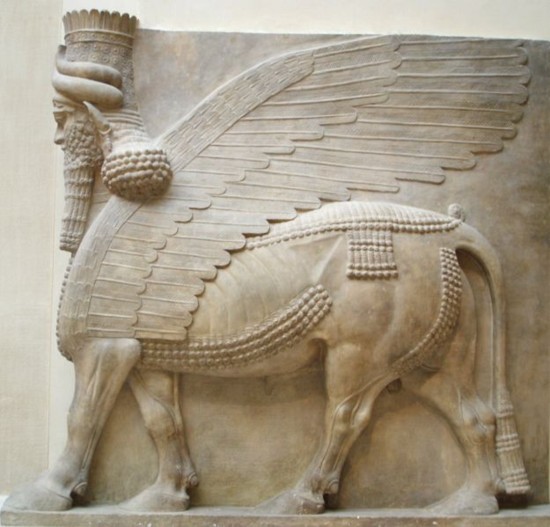 |
|
An Assyrian winged bull |
Buried beneath huge mounds, on which wandering tribes had
erected tents, and on which they buried their dead, were the remains of
splendid palaces, vast cities, and temples erected to Babylonian deities.
Engraved on colossal monuments, on brick tablets, on historic cylinders,
were national annals, chronological tables, lists of dynasties, scientific
and artistic treatises, and huge statues of deities and heroes almost
rivalled the stupendous monuments of Egypt in size and grandeur; and
sculptured walls and friezes illustrated the battles, sieges, victories,
hunting expeditions, and social habits of the dead Assyrians and
Babylonians. Forty years ago, the world knew little with certainty
of these dead empires. Now we have a history as grand as that of
Greece and Rome, and nearly as familiar to the scholar.
Perseverance, overcoming all difficulties and
oppositions—and there were many—has discovered the palaces and
monuments, and deciphered the strange characters in which the secrets of
the past were hidden; and to Rawlinson, Botta, Layard, George Smith, and
Rassam we owe the greatest of all revelations of long-hidden history.
|
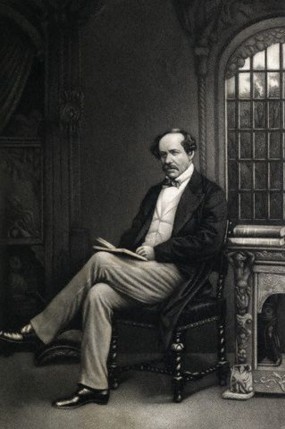 |
|
Sir Henry Creswicke Rawlinson (1810–95)
Soldier and orientalist, sometimes referred
to as the "Father of Assyriology." |
Long since, a few fragments of baked clay with strange markings were
brought to Western Europe, and submitted to the scrutiny of men of science
in England, France, and Germany. Some thought they could trace
alphabetic forms in the wedge-shaped marks; others saw only chisel
chippings having no meaning. At length, the discovery of large rock
inscriptions at Behistun, in Persia, on the perpendicular side of a lofty
rock, excited attention, and Colonel Rawlinson, after careful examination,
found that one of the three inscriptions was in a language which his
knowledge of Persian enabled him to read, and by comparing it with the
others he came to the conclusion that (as in the case of the Rosetta stone
in Egypt) the three inscriptions had the same meaning. By great
effort he penetrated the secret of the wedge-shaped or cuneiform character
in which one of the inscriptions was written; and it was then discovered
that the letters were nearly identical with the markings on the fragments
which had been brought to Europe.
Great attention was now directed to the subject. It had
been suggested that important discoveries might perhaps be made if some of
the massive mounds were explored; and, in 1843, M. Botta, French consul at
the Turkish town of Mosul, on the Tigris, having, with considerable
difficulty, obtained the necessary authorization, began excavations in a
huge mound known as Khorsabad, fourteen miles from Mosul, and was rewarded
by discovering extensive remains of an Assyrian palace. Three years
afterwards, Mr. Layard, who had been for some time greatly interested in
the subject, began more extensive excavations, which were continued for
more than two years, and made discoveries of the most remarkable
character, described in his great work, "Nineveh and its Remains," and
"Monuments of Nineveh;" the stupendous statues and sculptured slabs
preserved in the British Museum, and the casts from them in the Crystal
Palace show the extent and importance of his discoveries.
|
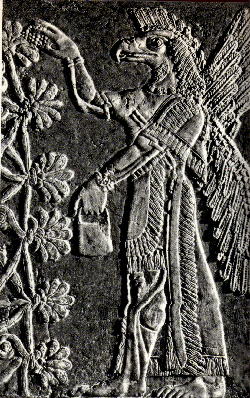 |
|
Assyrian hawk-headed divinity |
About 1870, Mr. George Smith, a young engraver, who had studied with
indomitable perseverance the inscriptions on the monuments and slabs, and
had been rewarded by an appointment in the department of Egyptian and
Oriental antiquities in the British Museum, undertook the direction of
renewed explorations, and his success was most remarkable. He sent
home a very great number of inscribed tablets and cylinders, containing
chronologies, calendars, dynastic records, and national annals, and, above
all in interest, records in the cuneiform character of the history of
Creation and the Flood, coinciding in a striking manner with the Biblical
records. Unfortunately, Mr. Smith's strength failed when undertaking
a second expedition, and he died at Aleppo, in 1876.
In 1877, Mr. Hormuzd Rassam, who had been an assistant to Mr.
Layard, was sent by the trustees of the British Museum to make further
explorations. He excavated a mound known as Balawat, about nine
miles north-east of the scene of Layard's labours, and he succeeded in
revealing other palaces and securing many interesting objects,
pre-eminently, a large pair of bronze gates, covered with sculptures in an
advanced style of art, representing the campaigns of the great Assyrian
monarch, Shalmanezer II. There are three hundred square feet of
richly worked bronze, and these wonderful records of the past are now the
choicest treasures in the vast Assyrian collection of the British Museum.
CHAPTER VI.
WITH the progress of civilization, Enterprise took
more diversified forms. First, man was summoned to display this
commanding quality of mind in the subjugation or destruction of the
stronger and fiercer animals; then he had to enter on the perilous
adventure into strange regions by land, and the hazardous transit of the
ocean, in search of still more unknown countries. We have just
glanced at another department of enterprise—the search for antiquities;
and the subject was placed in this order because it seemed naturally
connected with the perils of travel. But enterprise had taken a
thousand forms before men began to venture on great dangers for the
attainment of more certain knowledge of the past: the hewing of rocks and
levelling of forests, the disembowelling of mines, the construction of
highways and harbours, the erection of bridges and lighthouses, of Cyclopæan
piles and pyramids, of obelisks and columns, of aqueducts and walls of
cities—these, and a thousand other displays of strength, genius, and
skill, were among the "Triumphs of Enterprise" ages ago, and they are now
succeeded by the formation of railways, and the myriad-fold enterprises of
modern science.
How much would we not give for an authentic account of those
mysterious enterprises—the building of Stonehenge, of the round towers of
Ireland, and of the multitudinous "Druidical" monuments, as they are
termed, which are scattered in immense masses over Spain and other parts
of the continent? We are left to conjecture for their origin, and
our knowledge of it may never reach to certainty. The venerable
pyramids themselves are equally mysterious, both as it regards the
purposes far which they were erected and the means of erecting them.
The Cyclopæan masses of stone which form
the foundations of the ruined temple at Balbec (masses which dwarf the
stones of the Pyramids), as well as the recently discovered remains in
Central America, stretch back into the far Past, and also puzzle and
confound all human judgment and reckoning.
Again, even of some of the more recent erections of
antiquity, opinion is divided as to the true cause of carrying out such
enterprises. In this predicament antiquarian criticism places the
Roman aqueducts—those immense structures, formed often of several miles
of arches, on which water was conveyed over valleys. From a passage
in Pliny it is argued that the Romans were really acquainted with the
hydrostatic truth that water will rise to its own level; that these
immense edifices were erected rather from reasons of state policy than
from ignorance, the construction of them serving to employ turbulent
spirits. All this, however, is doubtful, and it may be that real
ignorance stimulated the Romans to carry on and complete these gigantic
undertakings which abound in their empire. One, it may be observed,
which was begun by Caius Cæsar, but
completed by Claudius, and therefore called the Claudian aqueduct, was
forty miles in length, and was raised sufficiently to distribute water
over the seven hills of the imperial mistress of the world.
|
 |
|
Pont du Gard, France, a Roman aqueduct built ca. 19
BC. |
But above all the civil enterprises of the Romans we ought to
place their roads; these grand and enduring highways, indeed, stamped
Europe with a new feature, and the civilized likeness thus impressed on
her was not effaced until railroads gave the initiative to a new
civilization. We cannot refrain from quoting Gibbon's masterly
description of the Roman highways; it occurs after he has been depicturing
the subordinate Roman capitals in Asia Minor, Syria, and Egypt—
"All these cities were connected with
each other and with the capital by the public highways, which, issuing
from the Forum at Rome, traversed Italy, pervaded the provinces, and were
terminated only by the frontiers of the empire. If we carefully
trace the distance from the wall of Antoninus (in Scotland) to Rome, and
from thence to Jerusalem, it will be found that the great chain of
communication from the north-west to the south-east point of the empire
was drawn out to the length of 4030 Roman (or 3740 English) miles.
The public roads were accurately divided by milestones, and ran in a
direct line from one city to another, with very little respect for the
obstacles either of nature or private property. Mountains were
perforated, and bold arches thrown over the broadest and most rapid
streams; the middle part of the road was raised into a terrace which
commanded the adjacent country, consisting of several strata of sand,
gravel, and cement, and was paved with large stones, or in some places
near the capital, with granite. Such was the solid construction of
the Roman highways, whose firmness has not entirely yielded to the effect
of fifteen centuries. They united the subjects of the most distant
provinces by an easy and familiar intercourse; but their primary object
had been to facilitate the marches of the legions, nor was any country
considered as completely subdued till it had been rendered in all its
parts pervious to the arms and authority of the conqueror. The
advantage of receiving the earliest intelligence, and of conveying their
orders with celerity, induced the emperors to establish throughout their
extensive dominions the regular institution of posts. Houses were
everywhere erected at the distance of five or six miles; each of them was
constantly provided with forty horses, and by the help of these relays it
was easy to travel a hundred miles in a day along the Roman roads.
The use of the posts was allowed to those who claimed it by an imperial
mandate; but though originally intended for the public service, it was
sometimes indulged to the business or conveniency of private citizens."
From other accounts we learn that the Roman roads varied in
importance and uses. The great lines were called "Prætorian
ways," as being under the direction of the prætors,
and those formed the roads for military intercourse. Other lines
were exclusively adapted for commerce or civil intercourse, and were under
the direction of consuls. Both kinds were formed in a similar
manner. The plan on which they were made was more calculated for
durability than ease to the traveller, and for our modern wheel carriages
they would be found particularly objectionable. Whatever was their
entire breadth the centre constituted the beaten track, and was made of
large ill-dressed stones laid side by side to form a compact mass of from
twelve to twenty feet broad, and therefore in their external aspect they
were but coarse stone causeways.
Some of the Roman roads had double lines of this solid
pavement, with a smooth brick path for foot passengers, and at intervals
along the sides there were elevated stones on which travellers could rest,
or from which cavalry could easily mount their horses. One important
feature in the construction of all the Roman roads was the bottoming of
them with solid materials. Their first operation seems to have been
the removal of all loose earth or soft matter which might work upwards to
the surface, and then they laid courses of small stones, or broken tiles
and earthenware, with a course of cement above, and upon that were placed
the heavy stones for the causeway; thus a more substantial and durable
pavement was formed, the expense being defrayed from the public treasury.
Various remains of Roman roads of this kind still exist in France, and
also in different parts of Britain. One of the chief Roman
thoroughfares, in an oblique direction across the country from London to
the western part of Scotland, was long known by the name of Watling
Street, and the name has been perpetuated in the appellation of one of the
streets of the metropolis.
|
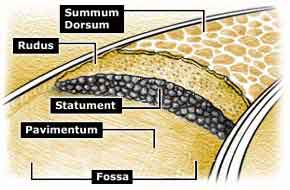 |
|
Roman road construction |
In the construction of their amphitheatres and other places
of public amusement, the Romans far transcended modern nations, in none of
which does a theatre exist of dimensions at all comparable with those of
the cities in the Roman empire. The ruins of the Colosseum, in Rome
itself, are the source of wonder to every visitor. The beautiful lines of
Byron on these magnificent remains of Roman civilization are well known.
Respecting numerous other enterprises of the ancient world,
interesting but imperfect accounts remain. Such are the narratives
of what were termed the "Seven Wonders of the World." It is time,
however, to leave antiquity—or, at least, classic antiquity—to speak of
one wondrous enterprise—that of a nation at the very "ends of the earth,"
of whom indeed many wonders are told.
Bell, the enterprising traveller, presents the clearest
account of the celebrated "Great Wall of China." "On the 2nd of
November, 1720, about noon," says he,
"we could perceive the famous wall,
running along the tops of the mountains, towards the northeast. One
of our people cried out 'land!' as if we had been all this while at sea.
It was now, as nearly as I can compute, about forty English miles from us,
and appeared white at this distance. The appearance of it, running
from one high rock to another, with square towers at certain intervals,
even at this distance is most magnificent."
In two days they arrived at the foot of this mighty barrier,
and entered through a great gate into China. Here a thousand men
were perpetually on guard, by the officers commanding whom they were
received with much politeness, and invited to tea. "The long, or
endless wall, as it is commonly called," continues Bell,
"encompasses all the north and west
parts of China. It was built about six hundred years ago by one of
the emperors, to prevent the frequent incursions of the Mongols and other
western Tartars, who made a practice of assembling numerous troops of
horse, and invading the country in different places. The Chinese
frontiers were too extensive to be guarded against such bold and numerous
enemies, who, after plundering and destroying a wealthy country, returned
to their own loaded with spoils.
"The Chinese, finding all precautions ineffectual to put a
stop to the inroads of such barbarians, at last resolved to build this
famous wall. It begins in the province of Leotong, at the bottom of
the Bay of Nankin, and proceeds across rivers, and over the tops of the
highest mountains, without interruption, keeping nearly along the circular
ridge of barren rocks that surround the country to the north and west;
and, after running southwards about twelve hundred English miles, ends in
impassable mountains and sandy deserts."
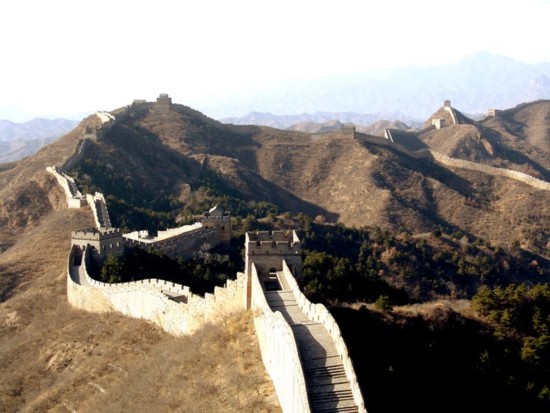 |
|
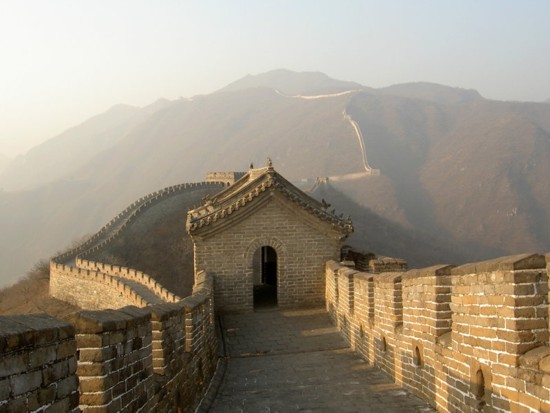 |
|
The Great Wall comprises a series of stone and
earthen fortifications, built between 5th century BC and the 17th
century to protect the northern borders of the Chinese Empire |
This is an engraving of a small portion of this wonderful
work. At the top is represented a piece of the wall, with one of the
towers, as it is seen by a person standing on the ground.
Immediately under it is a bird's-eye view of the same, representing the
dimensions and position of the tower, in relation to the wall. And
on the left side is a section which shows how the masonry is
constructed—of two walls getting thinner towards the top, and the
intermediate space filled in with work of a rougher kind.
"The foundation," continues Bell,
"consists of large blocks of square
stones, laid in mortar; but the rest of the wall is built of brick.
The whole is so strong and well-built as to need almost no repair, and, in
such a dry climate, may remain in this condition for many ages. Its
height and breadth are not equal in every place; nor, indeed, is it
necessary they should. When carried over steep rocks, where no horse
can pass, it is about fifteen or twenty feet high, and broad in
proportion; but, when running through a valley, or crossing a river, there
you strong a strong wall, about thirty feet high, with square towers at
the distance of a bow-shot from one another, and embrasures at equal
distances. The top of the wall is flat, and paved with broad
freestones; and where it rises over a rock, or any eminence, you ascend by
a fine easy stone stair. The bridges over rivers and torrents are
exceedingly neat, being both well contrived and executed. They have
two stories of arches, one above another, to afford sufficient passage for
the waters on sudden rains and floods."
Bell was also informed by the Chinese that this wall was
completed within the space of five years; every sixth man in the empire
having been compelled to work at it, or find a substitute. The date
of its erection, however, is considered uncertain; and therefore this
account may also be untrue. Gibbon gives the third century before
the Christian era as the date of its construction, and assigns it a length
of fifteen hundred miles. Du Pauw reduces the length to four hundred
and fifty miles, not choosing to consider the western branch, "which," he
says, "is of earth, worthy the name of a wall." Many writers judge
it to be a very recent work, or, at least, of as modern a date as on this
side the thirteenth century, since it is not mentioned by Marco Polo.
Yet tea is not mentioned by him, although the Chinese have used it
for thousands of years. If it be true that much of Marco Polo's
manuscript was destroyed because his friends ignorantly believed his
wondrous relations (such as the burning of a "black stone," or coal, by
the Chinese for fuel) to be false, the emission of allusions to the Great
Wall, in our copies of Marco Polo will be no argument against its
antiquity.
Another of the architectural wonders of China was the great
Porcelain Tower of Nankin, erected by the Emperor Yang-Loh, in 1413, and
destroyed by the rebels between 1853 and 1864. It was 322 feet high,
octagonal in form, and consisted of nine stories.
A wonderful construction is the "Slide of Alpnach," in
Switzerland, formed to enable the timber from the great forests of Mount
Pilatus to be brought down.
In November, 1816, Mr. Rulph, of Rentingen, and three other
Swiss gentlemen, entertaining more sanguine hopes, drew up a plan of a
slide, founded on trigonometrical measurements; and, having purchased a
certain extent of the forests from the commune of Alpnach for 6,000
crowns, began the construction of it.
The slide of Alpnach was formed of about 25,000 large pine
trees, deprived of their bark, and united together without the aid of
iron. It occupied about one hundred and sixty workmen during
eighteen months, and cost nearly one hundred thousand francs, or £4,166.
It was about three leagues, 44,000 English feet long, and terminated in
the Lake of Lucerne. It had the form of a trough about six feet
broad, and from three to six deep. Its bottom was formed of three
trees, the middle one of which had a groove cut out in the direction of
its length, for receiving small rills of water for the purpose of
diminishing the friction. The whole slide was sustained by about two
thousand supports, and in many places was attached in a very ingenious
manner to the rugged precipices of granite. The direction of the
slide was sometimes straight and sometimes zigzag, with an inclination of
from ten to eighteen degrees. It was often carried along the sides
of precipitous rocks, and sometimes over their summits; occasionally it
passed underground, and at other times over the deep gorges by
scaffoldings one hundred and twenty feet high.
Before any step could be taken in its erection it was
necessary to cut several thousand trees to obtain a passage through the
impenetrable thickets; and as the workmen advanced, men were posted at
certain distances in order to point out the road for their return.
Mr. Rulph was often obliged to be suspended by cords in order to descend
precipices many hundred feet high, to give directions, having scarcely two
good carpenters among his men, they having been hired as the occasion
offered.
All difficulties being at length surmounted, the larger
pines, which were about one hundred feet long; and ten inches thick at
their smaller extremity, ran through the space of three leagues, or
nearly nine miles, in three minutes and a half; and, during
their descent, appeared to be only a few feet in length. The
arrangements were extremely simple. Men were posted at regular
distances along the slide, and as soon as everything was ready the man at
the bottom called out to the next one above him, "Laclaez!"—Let
go! The cry was repeated, and reached the top of the slide in three
minutes; the man at the top of the slide then cried out to the one below,
"Il vient!"—It comes! As soon as the tree had reached the
bottom, and plunged into the lake, the cry of "Lachez!" was
repeated as before. By these means a tree descended every five or
six minutes. When a tree, by accident, escaped from the trough of
the slide, it often penetrated by its thickest extremity from eighteen to
twenty-four feet into the earth, and if it struck another tree, it cleft
it with the rapidity of lightning.
Such was the enterprising work undertaken and executed under
the direction of a single individual. This wondrous structure,
however, no longer exists, and scarcely a tree is to be seen on the flanks
of Mount Pilatus. Political events having taken away the demand for
timber, and another market having been found, the operation of cutting and
transporting the trees necessarily ceased.
Let us now glance at the enterprise of erecting a more
durable monument. Russia, proud of her Czar, the celebrated Peter the
Great, wished to erect a monument to his memory. Catherine the
Second was the morarch who had the direction of the work, and her choice
for an artist fell upon M. Falconet, who, in his conception of an
equestrian statue, resolved that the subordinate parts should bear an
equal impress of genius. "The pedestals in general use," he
observed, "had no distinctive feature, and adapt themselves equally well
to any subject. Being of so universal application they suggest no
new or elevated thoughts to the beholder." Falconet wished to wake
the Czar appear as the father and legislator of his people—great and
extraordinary in everything—undertaking and completing that which others
were unable to imagine. To carry out this conception a precipitous
rock was fixed on for the pedestal, on which the statue should appear with
characteristics distinguishing it from those erected to other sovereigns.
|
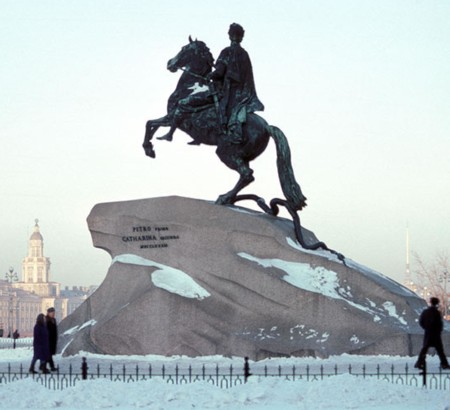
|
|
Equestrian statue of Peter the
Great
by Etienne-Maurice Falconet (1768-82) |
Falconet's first idea was to form this pedestal of six masses of
rock, bound together with bars of iron or copper; but the objection was
urged, that the natural decay of the bands would cause a disruption of the
various parts, and present a ruinous aspect, while it would be difficult
to insure perfect uniformity in the quality and appearance of the
different blocks. The next proposal was to form it of one whole rock; but
this appeared impossible, and in a report to the senate it was stated that
the expense would be so enormous as almost to justify the abandonment of
the undertaking. At length it was resolved to bring to the city of St.
Petersburg the largest rock that could be found, cost what it might.
The search for a huge mass of rock was begun, but the whole summer was
passed in vain exploration. The idea of forming the pedestal of several
pieces had again been entertained, when an immense stone was discovered
near Cronstadt, which it was determined to use as the principal mass. Various mechanics having been applied to, refused to undertake the task of
removing this stone, as did likewise the Russian Admiralty.
Fortunately for M. Falconet, he was acquainted with a native of Cephalonia,
who had assumed the name of Lascary, and who, while serving in the corps
of cadets, had given high proofs of mechanic skill. Lascary had all along
strenuously recommended the adoption of the original design, and now
undertook the formation of the pedestal. A few days after his appointment
to this commission he received information from a peasant of a large rock
lying in a marsh near a bay in the Gulf of Finland, about twenty miles
from St. Petersburg by water. The stone was examined, and the base, by
sounding around it, was found to be flat. It was a parallelopipedon in
form, and was forty-two feet long, twenty-seven feet wide, and twenty-one
feet high. These were dimensions sufficiently extensive to realize the
conceptions of M. Falconet. The authorities, when the mass was beheld,
again recommended its being cut into separate portions for convenient
removal. The Empress Catherine and her minister Betzky, were, however, on
the side of Lascary, and orders were imperatively given to commence the
strange enterprise.
The resolution was taken by M. Lascary to remove the stone without the use
of rollers, as these not only present a long surface, which increases the
friction and thereby impedes speed, but are not easily made of the great
diameter that would have been required owing to the soft and yielding
nature of the ground on which the work was to be performed. Spherical
bodies, revolving in a metallic groove, were then chosen as the means of
transport. These offered many advantages; their motion is more prompt than
that of rollers, with a less degree of friction, as they present but small
points of contact. Beams of wood, of a foot square, and thirty-three feet
in length, were then prepared; one side was hollowed in the form of a
gutter, and lined, the sides being convex to the thickness of two inches,
with a composition of copper and tin. Balls of the same composite metal,
five inches in diameter, were then made, to bear only on the bottom of the
groove. These beams were intended to be placed on the ground in a line in
front of the stone, while upon them were reversed two other beams prepared
in a similar manner, each forty-two feet long and one foot and a half
square, connected as a frame by stretchers and bars of iron fourteen feet
in length, carefully secured by ruts, screws, and bolts.
A load of three thousand pounds, when placed on the working model (which
had been first constructed) was found to move with ease. Betzky, the
minister, was pleased with the exhibition of the model; but the crowds who
came to witness it cried, "A mountain upon eggs!" But Lascary was not to
be driven from his purpose, so intelligently formed, by a little
unthinking clamour.
The rock lay in a wild and deserted part of the country, and therefore the
first thing to be done was to build barracks capable of accommodating four
hundred labourers, artisans, and others. These, with M. Lascary, were all
lodged on the spot, as the readiest means of forwarding the work. From the
rock to the river Neva a line of road was then cleared a distance of six versts, or twenty-one thousand English feet, to a width of one hundred and
twenty feet, in order to gain space for the various operations and to give
a free circulation of air, so essential to the health of workmen in a
marshy district, as well as to the drying and freezing of the ground—a
point of much importance when the enormous weight to be removed is
considered. The operation of disinterring the rock was commenced in
December, when the influence of the frosts began to be felt. It was
imbedded to the depth of fifteen feet: the excavation required to be of
great width—eighty-four feet all round—to admit of turning the stone,
which did not lie in the most favourable position for removal. An inclined
plane, six hundred feet in length, was afterwards made, by means of which,
when the stone was turned, it might be drawn up to the level surface.
Objectors said it would be impossible to place the monster mass of rock
upon the machine destined to transport it; but Lascary was still unshaken. Preferring simplicity to complication, he resolved to employ ordinary
levers, known technically as levers of the first order. These were made of
three masts, each sixty-five feet in length, and a foot and a half in
diameter at the larger end, firmly bound together. To lessen the
difficulty of moving these, triangles of thirty feet high were erected,
with windlasses attached near the base, from which a cord, passing through
a pulley at the top, was fastened to the smaller end of the lever, which
being drawn up to the top of the triangle, was ready for the operation of
turning; each of these levers was calculated to raise a weight of two
hundred thousand pounds.
A row of piles had been driven into the ground at the proper distance from
the stone on one side, to serve as a fulcrum; and on the other a series of
piles were disposed as a platform, to prevent the sinking of the mass on
its descent. Twelve levers, with three men to each, were stationed at the
side to be lifted, and the lower extremities being placed under the mass,
the upper ends were drawn downwards by the united action of the twelve
windlasses. When the stone rose to the height of a foot, beams and wedges
were then driven underneath to maintain it in that position, while the
levers were arranged for a second lift. To assist the action of the
levers, large iron rings were soldered into the upper corner of the rock,
from which small cables were passed to four capstans each turned by
thirty-six men, thus maintaining a steady strain, while the stone was
prevented from returning to its original position when the levers were
shifted. These operations were repeated until the rock was raised nearly
to an equipoise, when cables from six other capstans were attached to the
opposite side, to guard against a too sudden descent; and as a further
precaution against fracture, abed six feet in thickness, of hay and moss
intermingled, was placed to receive the rock, on which it was at length
happily laid. As it was of great importance that all the workmen should
act at one and the same time, two drummers were stationed on the top of
the stone, who, at a sign from the engineer, gave the necessary signals on
their drums, and secured the certainty of order and precision in the
various operations.
The machinery for the removal had, in the meantime, been finished. Of the
lower grooved beams already described, six pairs were prepared, so that
when the rock had advanced over one pair they might be drawn forward and
placed in a line in advance of the foremost, without interrupting the
movements. The balls were laid in the grooves two feet apart; the upper
frame, intended as the bed for the rock, placed above. The mass, weighing
in its original form four millions of pounds, or nearly eighteen hundred
tons, was then raised by means of powerful screws, and deposited on the
frame, when it was drawn up the inclined plane by the united force of six
capstans. The road did not proceed in a direct line to the river, owing to
the soft state of portions of the marsh. It was impossible in many places
to reach a firm foundation with piles fifty feet in length. This naturally
added to the difficulties of the transport, as the direction of the
draught had frequently to be changed. Piles were driven along the whole
line on both sides, at distances of three hundred feet apart; to these the
cables were made fast, while the capstans revolved, two of which were
found sufficient to draw the stone on a level surface, while on unequal
ground four were required. From five hundred to twelve hundred feet were
got over daily, which, when regard is had to the short winter days of five
hours in that high latitude, may be considered as rapid.
So interesting was the spectacle of the enormous mass when moving, with
the two drummers at their posts, the forge erected on it continually at
work, and forty workmen constantly employed in reducing it to a regular
form, that the empress and the court visited the spot to see the novel
sight; and notwithstanding the rigour of the season, crowds of persons of
all ranks went out every day as spectators. Small flat sledges were
attached to each side of the stone by ropes, on which were seated men
provided with iron levers, whose duty it was to prevent the balls, of
which fifteen on a side were used, from striking against each other and
thus impeding the motion. The tool-house was also attached, and moved with
the stone, in order that everything might be ready to hand when wanted. Balls and grooves of cast-iron were tried, but this material crumbled into
fragments as readily as if made with clay. No metal was found to bear the
weight so well as the mixture of copper and tin, and even with this the
balls were sometimes flattened and the grooves curled up when the pressure
by any accident became unequal. The utility of rollers was also tried; but
with double the number of capstans and the power, the cables broke, while
the stone did not advance one inch.
Suddenly the enterprise was checked by the sinking of the stone to a depth
of eighteen inches in the road, to the chagrin of the engineer, who was
suffering under a severe attack of marsh fever. Lascary, however, was not
disheartened, and speedily remedied the accident, spite of the idle
clamours of the multitude; and in six weeks from the time of first drawing
the stone from its bed, he had the satisfaction of seeing it safely
deposited in the temporary wharf built for the purpose of embarkation on
the banks of the river, when the charge fell into the hands of the
Admiralty, who had undertaken the transport by water to the city.
The Russian Admiralty had ordered a vessel or barge one hundred and eighty
feet in length, sixty-six feet in width, and seventeen feet from deck to
keel, to be built, with every appliance that skill could suggest to render
it capable of supporting the enormous burthen. Great precautions were now
necessary to prevent the rock falling into the stream. Water was let into
the vessel until she sank to the bottom of the river, which brought her
deck on a level with the wharf; the rock was then drawn on board by means
of two capstans placed on the deck of another vessel anchored at some
distance from the shore. Pumps and buckets were now brought into use to
clear the barge of the water with which she had been filled; but, to the
surprise and consternation of those engaged, she did not rise equally; the
centres bearing most of the weight remained at the bottom, while the head
and stern springing up gave to the whole the form of a sharp curve; the
timbers gave way, and, the seams opening, the water re- entered rapidly;
four hundred men were then set to bale, in order that every part might be
simultaneously cleared; but the curve became greater in proportion to the
diminution of the internal volume of water.
Lascary, who, from the time the rock had been placed on the deck of the
vessel, had been a simple spectator of these operations, which occupied
two weeks, now received orders to draw it again upon the wharf. He
immediately applied himself to remedy the error, which had been committed
in not distributing the weight equally, without removing the stone. He
first caused the head and stern of the barge to be loaded with large
stones, until they sank to a level with the centre; the rock was then
raised by means of screws and beams of timber, diverging to every part of
the vessel, placed under and against it, and on the removal of the screws,
the pressure being equal in every part, she regained her original form. The water was next pumped out, the stones removed from the head and stern,
and a ship lashed on each side of the barge, which on the 22nd of
September, 1769, arrived opposite the quay where it was intended to erect
the statue. The rock was raised from the spot where it was first found at
the end of March preceding.
The debarkation—not the least hazardous part of the enterprise—had yet
to be accomplished. As the river was here of a greater depth than at the
place of embarkation, rows of piles had been driven into the bottom
alongside the quay, and cut off level at a distance of eight feet below
the surface. On these the barge was rested; to prevent the recurrence of
the rising of the head and stern when the supports should be removed,
three masts lashed together, crossing the deck at each extremity, were
secured to the surface of the quay. It was then feared that, as the rock
approached the shore, the vessel might heel and precipitate it into the
river. This was obviated by fixing six other masts to the quay, which
projected across the whole breadth of the deck, and were made fast to a
vessel moored outside, thus presenting a counterpoise to the weight of the
stone. The grooved beams were laid ready, the cables secured, and, at the
moment of removing the last support, the drummers beat the signal, the men
at the capstans ran round with a cheer, the barge heeled slightly, which
accelerated the movement, and in an instant the rock was safely landed on
the quay.
The whole expense of the removal of this gigantic rock was about 70,000
roubles, or £14,000, while the materials which remained were worth
two-thirds of the sum.
Dr. Granville, in his "Travels to St. Petersburg," describing the public
promenade in front of the Admiralty in that city, says, "Here the
colossal equestrian statue of the founder of this magnificent city, placed
on a granite rock, seems to command the undivided attention of the
stranger. On approaching the rock, the simple inscription fixed on it in
bronze letters, 'Petro Primo, Catherina Secunda, MDCCLXXXII,' meets the
eye. The same inscription in the Russian language appears on the opposite
side. The area is inclosed within a handsome railing placed between
granite pillars. The idea of Falconet, the French architect, commissioned
to erect an equestrian statue to the extraordinary man at whose command a
few scattered huts of fishermen were converted into palaces, was to
represent the hero as conquering, by enterprise and personal courage,
difficulties almost insurmountable. This the artist imagined might be
properly represented by placing Peter on a fiery steed which he is
supposed to have taught by skill, management, and perseverance, to rush up
a steep and precipitous rock, to the very brink of the precipice, over
which the animal and the imperial rider pause, without fear, and in an
attitude of triumph. The horse rears with his forefeet in the air, and
seems to be impatient of restraint, while the sovereign, turned towards
the island, surveys with calm and serene countenance his capital rising
out of the waters, over which he extends the hand of protection. The bold
manner in which the group has been made to rest on the hind legs of the
horse only, is not more surprising than the skill with which advantage is
taken of the allegorical figure of the serpent of envy spurned by the
horse, to assist in upholding so gigantic a mass. This monument of bronze
is said to have been cast at a single jet. The head was modelled by
Mademoiselle Calot, a female artist of great merit, a contemporary of
Falconet, and is admitted to be a strong resemblance of Peter the Great. The height of the figure of the emperor is eleven feet; that of the horse
seventeen feet. The bronze is in the thinnest parts the fourth of an inch
only, and one inch in the thickest part; the general weight of metal in
the group is equal to 36,636 English pounds. I heard a a venerable Russian
nobleman, who was living at St. Petersburg when this monument was in
progress, relate that as soon as the artist had formed his conception of
the design he communicated it to the empress, together with the
impossibility of representing to nature so striking a position of man and
animal, without having before his eyes a horse and rider in the attitude
he had devised. General Melissino, an officer having the reputation of
being the most expert as well as boldest rider of the day, to whom the
difficulties of the architect were made known, offered to ride daily one
of Count Alexis Orloff's best Arabians out of that nobleman's stud, to the
summit of a steep artificial mound formed for the purpose, accustoming the
horse to gallop up to it and to halt suddenly, with his fore-legs raised,
pawing the air over the brink of a precipice. This dangerous experiment
was carried into effect by the general for some days, in the presence of
several spectators, and of Falconet, who sketched the various movements
and parts of the groups from day to day, and was thus enabled to produce
perhaps the finest—certainly the most correct—statue of the kind in
Europe."
It thus appears that enterprise characterized not only Lascary the
engineer, but Falconet the artist, Melissino the officer, who undertook to
depict the living model, and, in brief, the entire deed from beginning to
end. How strikingly might the parallel be continued with Peter himself! The young reader will find the history of the Czar, which he can peruse in
various forms, pregnant with lessons of enterprise to a degree beyond that
of any modern man, with the exception of Napoleon. In both their
histories, however, we are compelled to remind him, there is much to
censure; and in the history of the latter especially, much more to censure
than to praise.
If our own country be viewed with strictness, it will be found that we
have no great work of ornamental enterprise simply, at all comparable to
the one just sketched. Russia, nevertheless, can bear no comparison with
England in point of useful enterprises; she has nothing, for instance,
like the Eddystone light-house or the Plymouth breakwater. A few brief
sentences will serve to sketch the former. The first light-house built on
the Eddystone rock was constructed by Winstanley, in 1696 to 1700. While
some repairs were making under his inspection, the building was blown down
in a terrible hurricane, during the night of the 26th of November 1703,
and he and his workmen perished. Not a vestige, except some iron
stanchions and a chain, was left behind.
Rudyerd, in 1706, erected another, which was destroyed by fire, in 1755;
it was entirely of wood, except the five lower courses of stone on the
rock.
|
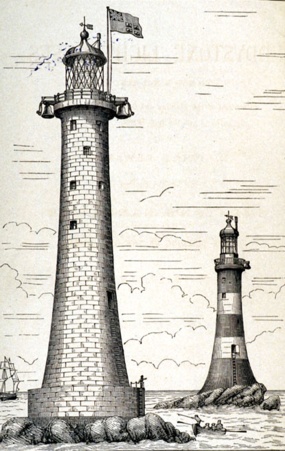 |
|
In 1882, John Smeaton’s
lighthouse of 1759 was replaced by a new tower, twice as tall as the
original, constructed on a nearby rock by James Douglass. |
The present edifice [Ed—see note below illustration] is a circular tower of stone sweeping up with a gentle
curve from the base, and gradually diminishing to the top, somewhat
similar to the swelling of the trunk of a tree. The tower is furnished
with a door and windows, and a staircase and ladders for ascending to the
lantern, through the apartments of those who keep watch. Mr. Smeaton
undertook the arduous task of constructing the present light-house, in the
spring of 1756, and completed it in about three years. In order to form
his foundation, Smeaton accurately measured the very irregular surface of
the rock, and made a model of it. Granite, partially worked, forms the
foundation; every outside piece is grafted into the rock, to sustain more
effectually the action of the sea; a border of three inches effects also a
kind of socket for the foundation. Each course of masonry is dovetailed
together, in the most skilful manner, and each layer of masonry is
strongly cemented together and connected by oaken plugs, and the whole
strongly clamped. The general weight of the stones employed is a ton, and
some few are two tons. In the solid work the centre stones were fixed
first, and all the courses were fitted on a platform and accurately
adjusted, before they were removed to the rock.
|
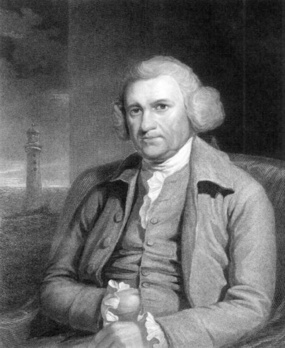 |
|
John Smeaton (1724–1792)
Civil Engineer |
The base of the tower is about twenty-six feet nine inches in diameter;
the diameter at the top of the solid masonry is about nineteen feet nine
inches; and the height of the solid masonry is thirteen feet from the
foundation. The height of the tower from the centre of the base is
sixty-one feet seven inches; the lantern, the base of which is stone, is
twenty-four feet. The whole height is eighty-five feet seven inches; and
the Eddystone light-house has not only the merit of utility, but also of
beauty, strength, and originality, and is itself sufficient to immortalise
the name of the architect.
The Breakwater thrown across Plymouth Sound is another of the great useful
enterprises of Britain. Mr. Rennie was the distinguished engineer
appointed to perform this work. He knew that to resist the force of the
heavy sea which rolls into the Sound from the south and south-west, a very
considerable slope would be necessary for the breakwater, and,
accordingly, it is so constructed. He also perceived that great masses of
stones from one to ten tons each would be required.
|
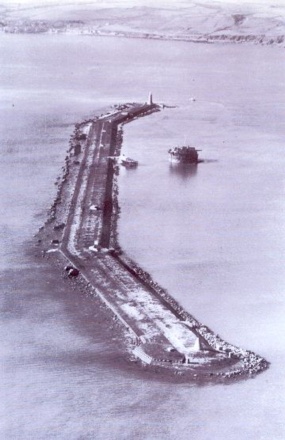 |
|
Plymouth Breakwater was commenced in 1811 and finally
completed in 1841, 4,000,000 tons of rock being used in its
construction. |
The quarries from which these were procured are situated at Oreston, on
the eastern shore of Catwater; they lie under a surface of about
twenty-five acres; and were purchased from the Duke of Bedford for
£10,000. They consist of one vast mass of compact close-grained marble,
many specimens of which are beautifully variegated; seams of clay,
however, are interspersed through the rock, in which there are large
cavities, some empty, and others partially filled with clay. In one of
these caverns in the solid rock, fifteen feet wide, forty-five feet long,
and twelve feet deep, filled nearly with compact clay, were found imbedded
fossil bones belonging to the rhinoceros, being portions of the skeletons
of three different animals, all of them in the most perfect state of
preservation, every part of their surface being entire to a degree which
Sir Everard Home said he had never observed in specimens of that kind
before. The part of the cavity in which these bones were found was seventy
feet below the surface of the solid rock, sixty feet horizontally from the
edge of the cliff where it was first begun to work the quarry, and one
hundred and sixty feet from the original edge of the Catwater. Every side
of the cavern was solid rock, the inside had no incrustation of
stalactite, nor was there any external communication through the rock in
which it was imbedded, nor any appearance of an opening from above being
closed by infiltration. When therefore, and in what manner, these bones
came into that situation, is among the secret and wonderful operations of
nature which will probably never be revealed to mankind.
M. Dupin, an intelligent observer of our great naval and commercial
enterprises, gives the following description of the working of the
quarries from which the Breakwater stone was procured.
"The sight of the
operations which I have just described, those enormous masses of marble
that the quarry-men strike with heavy strokes of their hammers; and those
aerial roads or flying bridges which serve for the removal of the superstratum of earth; those lines of cranes all at work at the same
moment; the trucks all in motion; the arrival, the loading, and the
departure of the vessels; all this forms one of the most imposing sights
that can strike a friend to the great works of art. At fixed hours, the
sound of a bell is heard in order to announce the blastings of the quarry. The operations instantly cease on all sides, the workmen retire; all
becomes silence and solitude; this universal silence renders still more
imposing the sound of the explosion, the splitting of the rocks, their
ponderous fall and the prolonged sound of the echoes."
These huge blocks of stone were conveyed from the quarries on trucks,
along iron railways, to the quays, and from thence into the holds of the
vessels built expressly for the purpose. On their arrival over the
line of the Breakwater, they are discharged from the trucks by means of
what is called a typing-frame, at the stern of the vessel, which, falling like a
trap-door, lets the stone into the sea. In this manner a cargo of sixteen
trucks, or eighteen tons, may be discharged in the space of forty or fifty
minutes. Two millions of tons of stone, and one million sterling in money,
was the calculation made at the outset, as requisite to complete this
great national work.
___________________
FERDINAND DE LESSEPS.
|
 |
|
Ferdinand Marie Vicomte de Lesseps (1805–1894)
French diplomat and builder of the Suez Canal. |
THE most remarkable achievement of engineering
enterprise in recent times, whether regarded as a triumph over natural
difficulties, political and commercial opposition, or in relation to the
importance of its results, is the Suez Canal—that water highway which
connects the Mediterranean and Red Seas, and opens up a short sea route to
India, China and the vast East generally.
More than two thousand years ago, the Egyptian Kings had
constructed a canal uniting one of the branches of the Nile with Suez; but
that was filled up with sand and other accumulations centuries since.
Traces of it are still visible, but, although the advantages of opening
communications between the two seas, and so avoiding the long sea route
round the Cape of Good Hope, were obvious, the difficulties attending the
construction of a canal across the isthmus (only about 76 miles wide),
appeared so insuperable that no engineer had the courage to undertake the
task until, in 1854, M. de Lesseps, a French engineer, submitted to Said
Pacha, Viceroy of Egypt, plans for forming a canal, wide and deep enough
for the largest ships.
Ferdinand de Lesseps was born at Versailles in 1805, and the
early part of his career was associated with diplomacy, or attaché
to the French consulate at Lisbon, and the Foreign Office at Paris.
In 1828 he was assistant-consul at Tunis, afterwards vice-consul in Egypt,
and subsequently held consulate appointments at Cairo, Rotterdam, Malaga,
Barcelona, Madrid, and Rome. To the varied commercial and political
knowledge necessarily acquired, he added great engineering attainments;
and, since having resolved on the construction of the great canal, he
devoted himself with amazing energy to the work. The disarrangements
and hindrances were great. There was political opposition.
Lord Palmerston, the British Minister, denounced the project. George
Stephenson, the great engineer who had allowed no difficulties to stand in
his own way in the construction of railways, visited the isthmus and
declared a canal to be totally impracticable. There were financial
obstructions, too, of no slight character. Nevertheless, the
indomitable M. de Lesseps persevered, a joint-stock company was formed,
and the canal was commenced. In November, 1869, the canal was
inaugurated with great ceremony, and the presence of many royal and
illustrious personages; and since then thousands of voyages by steamers
and other vessels of the largest size have been made through the great
highway. The canal is 100 miles long, 327 feet wide, and 26 feet
deep. Great towns have risen at each end, and busy settlements
formed along the route.
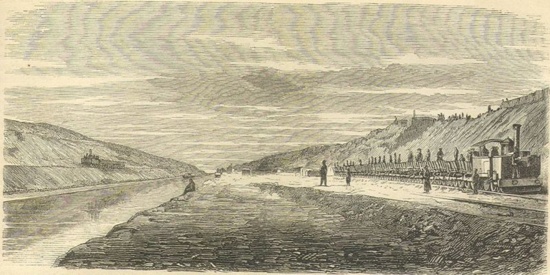 |
|
Suez Canal under construction |
M. de Lesseps was made a Viscount, and received the French
Cross of the Legion of Honour, and the freedom of the City of London.
He is now devoting his energies to the construction of a canal through the
isthmus of Panama, in Central America; it will unite the Atlantic and
Pacific Oceans.
THE END
___________________
SIMMONS & BOTTEN,
Printers, Shoe Lane, E.C. |